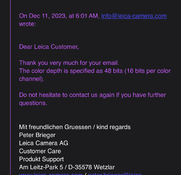There's no inherent relationship between dynamic range and bit 'depth'. Simply put, you can make a bit as wide or as narrow in terms of dynamic range as you want - it's arbitrary.
Also, the fact that a device outputs a nominal 16 bit signal doesn't mean its actual resolution is the same. It's generally lower, sometimes much less so.
I fully comprehend the fact that allocating 14 bits as a holder for data is fully dependent on the DR of the input unit...if you have two different units, one with 13-bits of actual differentiable data whlle the other has 14 bits of actual differentiable data, the bucket is identical (14 bits) but the data itself is better from
one of the two units. In the case of Canon, we have an entire generation of product, the dSLR of the 2002-2019 period, with increasing DR even though all use the identical 14-bit of data storage allocated, because the sensors and processing circuits got better over time.
My question was how does the
SAME PRODUCT description from the same company have
two different specifications both for number of bits allocated and in the Dynamic Range?! and in the
lower bit count of the two specifications it is stated as having a
wider DR? That contradiction itself illustrates the 'take quoted specs with a grain of salt' unless you fully understand the foundation of the claim.













